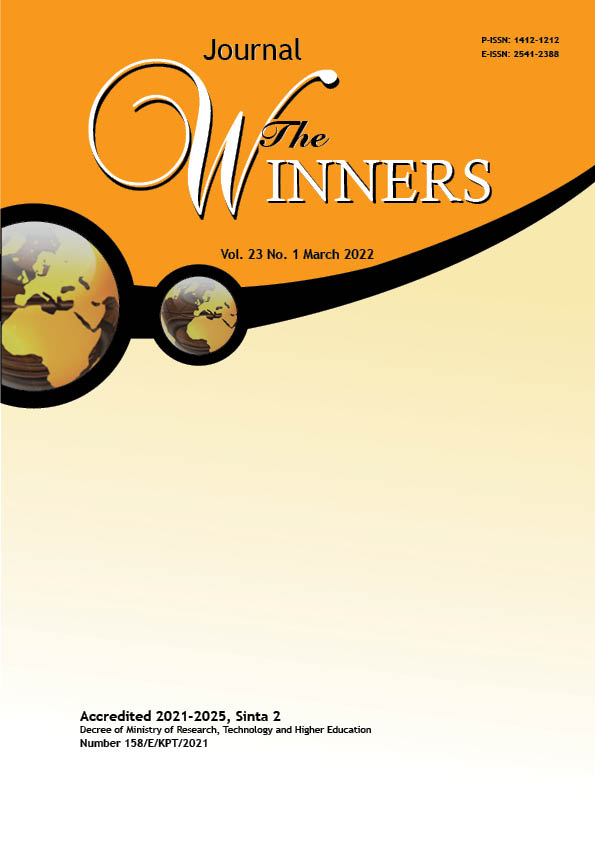The Effect of Perceived Usefulness and Perceived Easiness towards Behavioral Intention to Use Fintech by Indonesian MSMEs
DOI:
https://doi.org/10.21512/tw.v23i1.7078Keywords:
perceived usefulness, perceived easiness, behavioral intention, fintech, MSMEAbstract
The research aimed to test how are Micro Small Medium Enterprise (MSMEs) acceptance towards financial technology fintech). The number of MSME that using fintech is still need to be maximized. MSMEs were chosen as research object due to their numerous contribution in gross domestic product (GDP). Therefore, it was considered important to understand MSME’s notion to use fintech in their business operation, which is wellknown that financial technology could give a lot of services which may improve MSMEs performance. The research adopted the technology acceptance model (TAM) theory to determine the effect of the variable perceived of usefulness and perceived ease of use on behavioral intention to use fintech services by MSME entrepreneurs. Technology acceptance model had been the most widely applied model to measure and analyze a technology's use and acceptance. The descriptive quantitative research was applied. The analysis using multiple linear regression tests on 60 respondents. Respondents were managers of MSMEs who use financial technology services in their business operations in any form. Classical assumption testing was carried out to meet the requirements of multiple linear regression analysis. The data met the criteria for multiple linear regression. The results reveal that perceived of usefulness and perceived ease of use variables simultaneously affect the behavioral intention to use financial technology services. Partially, perceived of usefulness affects behavioral intention to use, as well as the perceived ease of use affects behavioral intention to use financial technology services.Â
References
Aboelmaged, M. & Gebba, T. R. (2013). Mobile banking adoption: An examination of technology acceptance model and theory of planned behavior. International Journal of Business Research and Development, 2(1), 35-50. https://doi.org/10.24102/ijbrd.v2i1.263
Abubakar, L. & Handayani, T. (2018). Financial technology: Legal challenges for Indonesia financial sector. IOP Conference Series: Earth and Environmental Science, 175. https://doi.org/10.1088/1755-1315%2F175%2F1%2F012204
Aditya, R. & Wardhana, A. (2016). Pengaruh perceived usefulness dan perceived ease of use terhadap behavioral intention dengan pendekatan Technology Acceptance Model (TAM) pada pengguna Instant Messaging LINE di Indonesia. Jurnal Siasat Bisnis, 20(1), 24-32. https://doi.org/10.20885/jsb.vol20.iss1.art3
Annur, C. M. (2019, June 28). Survei PwC: 74% UMKM belum dapat akses pembiayaan. Katadata. https://katadata.co.id/desysetyowati/digital/5e9a5182d753a/survei-pwc-74-umkm-belum-dapat-akses-pembiayaan
Asosiasi Fintech Indonesia. (2018). Fintech untuk Usaha Mikro Kecil Menengah tentang Asosiasi Fintech Indonesia.
Banding, M. P., Ashar, A., Juliana, A., Azis, M. I., & Thresia, Y. (2020). Financial technology for SMEs capital problems with crowdfunding method. Media Ekonomi dan Manajemen, 35(2), 150-163. https://doi.org/10.24856/mem.v35i2.1503
Candra, S., Nuruttarwiyah, F., & Hapsari, I. H. (2020). Revisited the technology acceptance model with e-trust for peer-to-peer lending in Indonesia (perspective from fintech users). International Journal of Technology, 11(4), 710-721. https://doi.org/10.14716/ijtech.v11i4.4032
Chuang, L.-M., Liu, C.-C., & Kao, H.-K. (2016). The adoption of fintech service: TAM perspective. International Journal of Management and Administrative Sciences (IJMAS), 3(7), 1-15.
Davis, F. D. (1989). Perceived usefulness, perceived ease of use, and user acceptance of information technology. Management Informatio System Quarterly, 13(3), 319-340. https://doi.org/10.5962/bhl.title.33621
DSResearch. (2019). Moving Towards A New Era In Indonesia’s Financial Industry. Fintech Report 2019. 1-10.
Ferdinand, A. (2002). Structural Equation Modeling dalam Penelitian Manajemen (3rd Ed.). Fakultas Ekonomi Universitas Diponegoro.
Handayani, W. P. P. & Harsono, M. (2016). Aplikasi technology acceptance model (TAM) pada komputerisasi kegiatan pertanahan. Jurnal Economia, 12(1), 13. https://doi.org/10.21831/economia.v12i1.8415
Hanggono, A., Ragil, H. S., & Heru, S. (2015). Analisis atas praktek TAM (Technology Acceptance Model) dalam mendukung bisnis online dengan memanfaatkan jejaring sosial Instagram. Jurnal Administrasi Bisnis Universitas Brawijaya, 26(1), 1-9.
Harahap, B. A., Idham, P. B., Kusuma, A. C. M., & Rakhman, R. N. (2017). Perkembangan financial technology terkait Central Bank Digital Currency (CBDC) terhadap transmisi kebijakan moneter dan makroekonomi. (Working Paper WP/2/2017). Bank Indonesia. http://publication-bi.org/repec/idn/wpaper/WP022017.pdf
Indrawan, R. (2019). Sinergitas Pengembangan KUMKM melalui Penguatan Peran antar Lembaga. Rapat Kerja Nasional. Kementerian Koperasi dan Usaha Kecil dan Menengah Republik Indonesia. https://docplayer.info/156603042-Sinergitas-pengembangan-kumkm-melalui-penguatan-peran-antar-lembaga.html
Leong, K. & Sung, A. (2018). FinTech (financial technology): What is it and how to use technologies to create business value in fintech way? International Journal of Innovation, Management and Technology, 9(2), 74–78. https://doi.org/10.18178/ijimt.2018.9.2.791
Lule, I., Omwansa, T. K., & Mwololo, T. W. (2012). Application of technology acceptance model (TAM) in m-Banking adoption in Kenya. International Journal of Computing and ICT Research, 6(1), 31-43.
Maksum, I. R., Rahayu, A. Y. S., & Kusumawardhani, D. (2020). A social enterprise approach to empowering micro, small and medium enterprises (SMEs) in Indonesia. Journal of Open Innovation: Technology, Market, and Complexity, 6(3). https://doi.org/10.3390/JOITMC6030050
Napitupulu, S., Rubini, A., Khasanah, K., & Rachmawati, A. (2017). Kajian perlindungan konsumen sektor jasa keuangan: Perlindungan konsumen pada fintech. Departemen Perlindungan Konsumen, Otoritas Jasa Keuangan, 1-86.
Safitri, T. A. (2020). The Development of Fintech in Indonesia. 436, 666-670. https://doi.org/10.2991/assehr.k.200529.139
Sekaran, U. & Bougie, R. (2009). Research Methods for Business: A Skill Building Approach (5th Ed.). John Wiley & Sons, Inc.
Sektor UKM terus didorong gunakan platform digital. (2019, January 24). Indonesia.go.id. https://indonesia.go.id/narasi/indonesia-dalam-angka/ekonomi/sektor-ukm-terus-didorong-gunakan-platform-digital
Singh, S., Sahni, M. M., & Kovid, R. K. (2020). What drives FinTech adoption? A multi-method evaluation using an adapted technology acceptance model. Management Decision, 58(8), 1675-1697. https://doi.org/10.1108/MD-09-2019-1318
Statistik fintech lending periode Desember 2019. (2020, January 31). Otoritas Jasa Keuangan. https://www.ojk.go.id/id/kanal/iknb/data-dan-statistik/fintech/Pages/Statistik-Fintech-Lending-Periode-Desember-2019.aspx
Sujarweni, W. (2014). Metode Penelitian: Lengkap, Praktis, dan Mudah Dipahami. Pustaka Baru Press.
Tambunan, T. (2019). Recent evidence of the development of micro, small and medium enterprises in Indonesia. Journal of Global Entrepreneurship Research, 9(1). https://doi.org/10.1186/s40497-018-0140-4
Venkatesh, V. (2000). Determinants of perceived ease of use: Integrating control, intrinsic motivation, and emotion into the technology acceptance model. Information Systems Research, 11(4), 342-365. https://doi.org/10.1287/isre.11.4.342.11872
Vijayasarathy, L. R. (2004). Predicting consumer intentions to use on-line shopping: The case for an augmented technology acceptance model. Information and Management, 41(6), 747-762. https://doi.org/10.1016/j.im.2003.08.011
Wibowo, P. (2017, February 01). Digital revolution: What it means for Indonesian business. McKinsey & Company. https://www.mckinsey.com/featured-insights/asia-pacific/digital-revolution-what-it-means-for-indonesian-business#
Winarto, W. W. A. (2020). Peran fintech dalam usaha mikro kecil dan menengah (UMKM). Jesya (Jurnal Ekonomi & Ekonomi Syariah), 3(1), 61-73. https://doi.org/10.36778/jesya.v3i1.132
Downloads
Published
How to Cite
Issue
Section
License
Copyright (c) 2021 Astri Wening Perwitasari

This work is licensed under a Creative Commons Attribution-ShareAlike 4.0 International License.
Authors who publish with this journal agree to the following terms:
a. Authors retain copyright and grant the journal right of first publication with the work simultaneously licensed under a Creative Commons Attribution License - Share Alike that allows others to share the work with an acknowledgment of the work's authorship and initial publication in this journal.
b. Authors are able to enter into separate, additional contractual arrangements for the non-exclusive distribution of the journal's published version of the work (e.g., post it to an institutional repository or publish it in a book), with an acknowledgment of its initial publication in this journal.
c. Authors are permitted and encouraged to post their work online (e.g., in institutional repositories or on their website) prior to and during the submission process, as it can lead to productive exchanges, as well as earlier and greater citation of published work.
USER RIGHTS
All articles published Open Access will be immediately and permanently free for everyone to read and download. We are continuously working with our author communities to select the best choice of license options, currently being defined for this journal as follows: Creative Commons Attribution-Share Alike (CC BY-SA)

















